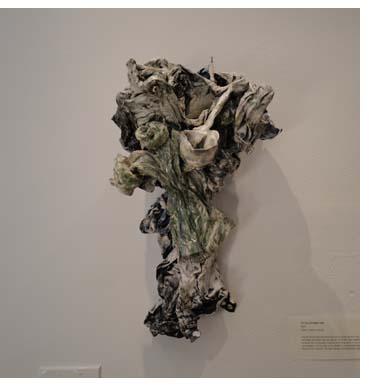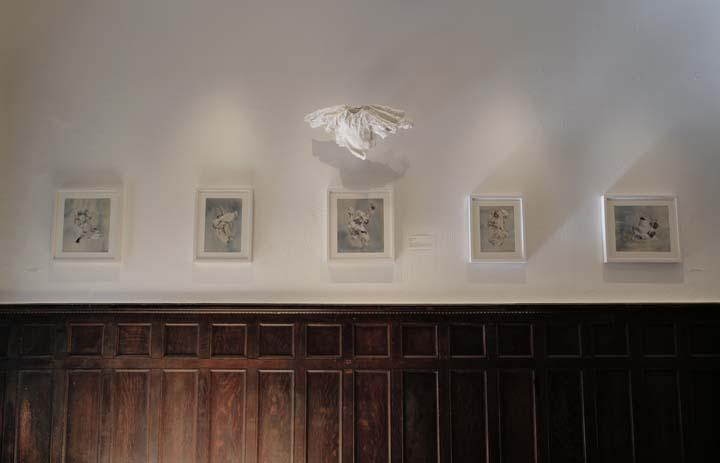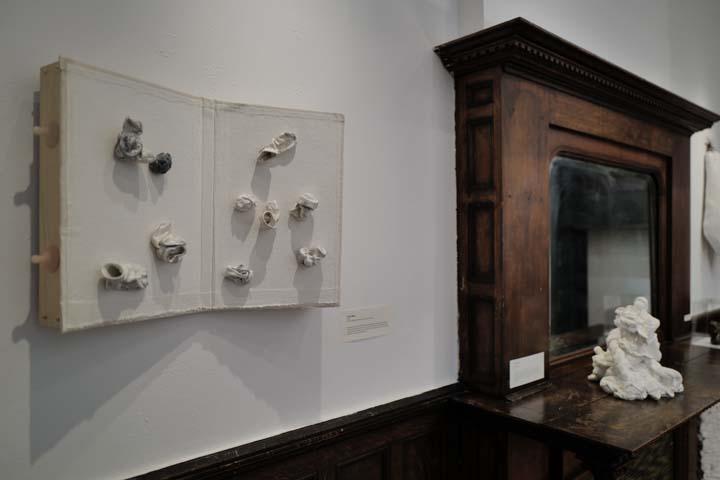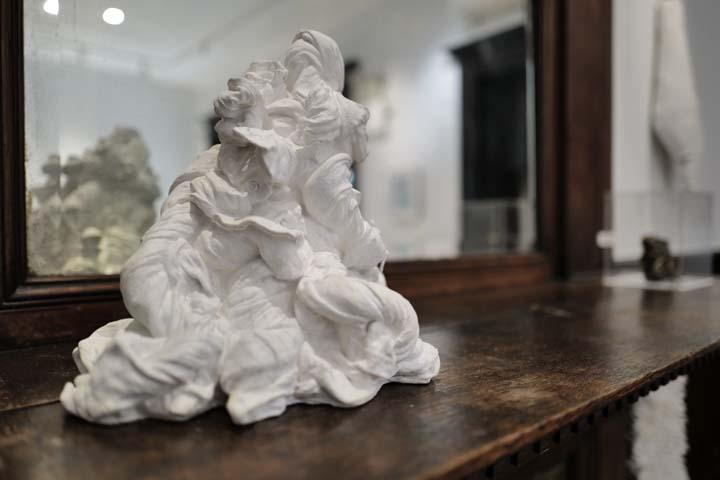Ana-Maria Morar: Hide & Seek
It’s an old joke (or perhaps a deep, unspoken fear) that artists turn to motherhood as subject matter when they’ve run out of ideas. But if that were ever true—and I doubt it was—Ana Maria Morar’s Hide & Seek offers a radiant counterargument. The exhibition, on view at Arts for Peace Gallery, is neither sentimental nor reactionary. Instead, it’s something far rarer: a meditation on the maternal that is structurally rigorous, emotionally unflinching, and materially inventive.
Morar, a former pupil of sculptor Leonid Lerman, clearly inherited her teacher’s classical discipline. Yet her works refuse to be bound by reverence. Instead, they take the domestic ephemera of motherhood—particularly her children’s outgrown clothing—and transform them, via plaster casting, into objects that hover between relic, fossil, and monument. They are arresting in the way a hushed confession is arresting: not because it shouts, but because it reveals.
The centerpiece of the show is the evolving One and Under series, which spans over seven years. In Out-growing I (2018), we see the delicate interplay between fabric and plaster. The former, soft and intimate, clings to memory; the latter, cold and unyielding, freezes time in its tracks. The result is not simply a sculpture, but a record of transition—a literal embodiment of what is outgrown and left behind.

More recent works take on a bolder tone. Holly Mess (2024)—yes, the pun is intentional—feels like an open book, refusing the tidy closures that traditional sculpture often aspires to. It is the entropy of motherhood made sacred: a ritual of unraveling, of making peace with disorder.
There’s a sense of humor here, too, but not at the expense of the subject. Rather, it’s the kind of humor that mothers (and maybe only mothers) are allowed: wry, lived-in, unsentimental. And then there is To My Younger Self (2024), where Morar introduces color for the first time. The material flirts with ceramic, but keeps the same tactile, layered feel of her plaster pieces. Here, the work seems to bloom inward—toward reflection, toward healing, toward self. It is no longer only about the child; it is also about the woman who became a mother.
A small collaborative book, Martin, from 4 to 5, closes the show with grace. In it, Morar transcribes her son’s language as it transforms from speech to writing. It’s a gesture that captures her whole project in miniature: a document of change, lovingly recorded and materially reimagined.
Now, allow me a brief confession. I am not a mother. In fact, I am not even a parent. I am just a man, wandering into this gallery on a quiet weekday afternoon, expecting to spend fifteen quiet minutes nodding at plaster casts of baby clothes. Instead, I found myself magnetized by each piece, unable to detach. Something about the way Morar frames care—as labor, as memory, as rupture—felt not only deeply moving, but personally revelatory. I walked out of Hide & Seek thinking about my own mother, and how little we speak of what she must have given up, left behind, or quietly endured. Her work, too, has been cast aside and forgotten, but in a different medium: the day-to-day.
It is often said that good art makes you see the world differently. Morar’s work goes a step further—it makes you see what you’ve forgotten to look for in the first place. And so, this is not only an exhibition to be seen. It is one to be felt. There is still time to witness it in the flesh, and I recommend you do just that. Not because it's fashionable (it isn’t), and not because it’s spectacular (it is), but because it is honest. It’s rare to see an artist handle such complex emotional terrain with both formal precision and open-heartedness. Ana-Maria Morar has made something beautiful, strange, and urgently human. You should go see it.
More at www.anamariamorar.com and @ammorar on Instagram. Photos courtesy of the artist.
Continuing through October 6 at Arts for Peace Gallery, 38 West 88th Street, New York, NY
Marco Palli is an Italian-American sculptor and multidisciplinary artist, born in Venezuela and based in New York City. Internationally recognized for his exploration of architectural, mechanical, and symbolic forms, his work spans materials from water clay to Carrara marble and Corten steel. With a background in structural engineering and an MBA in Management, his practice bridges technical precision and conceptual inquiry. His academic and teaching roles have included appointments in the U.S. and Latin America, such as Fordham University and the Universidad Católica in Chile. Since 2019, he has served as President and Board Director of Sculptors Alliance, a nonprofit dedicated to promoting the sculptural arts. More @marco.palli
If you would like to subscribe to DART: Design Arts Daily, please go here





